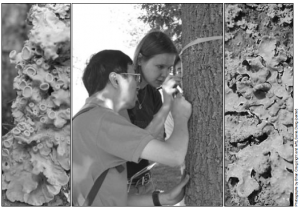Learning with Lichen: Using Epiphytic Lichens as Bio-indicators of Air Pollution

Originally appears in the Fall 2005 issue
It can be a challenge to make environmental problems such as air pollution concrete and meaningful to students. Students learn the general concepts and the big causes and effects — greenhouse gases, acid rain, climate change — but in many cases the problems seem so huge and intangible that students have difficulty grasping how their own daily lives are linked to them. Indeed, teachers and students can both be in danger of missing the trees for the forest, of being too conceptual and overlooking the details, the ‘little picture.’ As educators, we need to make environmental problems relevant, local and concrete: that is, to show students how these problems affect the local environment in ways that can be seen and felt. When teaching about air pollution, one way to accomplish these goals is to have your class monitor air quality using lichens as biological indicators.
What exactly are lichens?
On first glance, lichens may appear to be a type of moss, but on closer examination they reveal themselves to be a unique life form. A lichen is composed of not one, but two organisms: a fungus and an alga or cyanobacterium. The two organisms live in a symbiotic relationship in which the alga provides both partners with energy through photosynthesis and the fungus provides shelter and protection for the alga.
This content is restricted to subscribers only.
If you are not yet a subscriber, please consider taking out a subscription here.
If you are an existing subscriber, kindly log in or contact us at info@greenteacher.com for more information.





